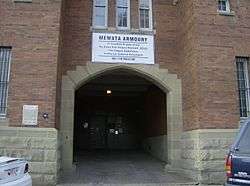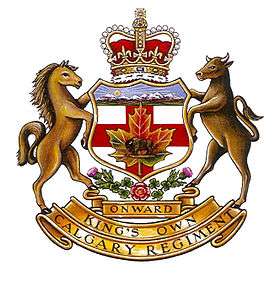The King's Own Calgary Regiment (RCAC)
| The King's Own Calgary Regiment (RCAC) | |
|---|---|
|
The King's Own Calgary Regiment cap badge | |
| Active | 1 April 1910 – present |
| Country | Canada |
| Branch | Primary Reserve (Militia) |
| Type | Mounted infantry |
| Role | Reconnaissance |
| Size | One regiment |
| Part of | 41 Canadian Brigade Group |
| Garrison/HQ | Calgary |
| Patron | George VI of Canada |
| Motto(s) | Onward |
| Colours | Oxford and Cambridge blue |
| March | "Colonel Bogey" |
| Engagements |
World War I World War II |
| Battle honours | Ypres, 1915, '17; Festubert, 1915; Mount Sorrel; Somme, 1916; Ancre Heights; Ancre, 1916; Arras, 1917, '18; Vimy, 1917; Hill 70; Passchendaele; Amiens; Scarpe, 1918; Drocourt-Quéant; Hindenburg Line; Canal du Nord; Valenciennes; France and Flanders, 1915–18; Dieppe; Sicily, 1943; Motta Montecorvino; San Leonardo; The Gully; Cassino II; Gustav Line; Pignataro; Liri Valley; Aquino; Trasimene Line; Arezzo; Advance to Florence; Cerrone; Italy, 1943–1945; North-West Europe, 1942, 1945; Afghanistan |
| Website |
www |
| Commanders | |
| Colonel-in-Chief | HM The Queen |
| Abbreviation | KOCR |
The King's Own Calgary Regiment (RCAC), or KOCR, is an armoured unit of the Canadian Forces Primary Reserve based at the Mewata Armoury in Calgary, Alberta.[1] The KOCR is part of 3rd Canadian Division's 41 Canadian Brigade Group.
History
 |
Colonel Bogey March
"Colonel Bogey March" is the authorized march of The King's Own Calgary Regiment (RCAC) of the Canadian Forces. This version is performed by the United States Navy Band. |
| Problems playing this file? See media help. | |
History 1910–1913
The regiment originated in 1910 with the creation of the 103rd Regiment (Calgary Rifles).
History 1914–1920
The 50th Battalion (Calgary), CEF, was an infantry battalion of the Canadian Expeditionary Force during the Great War. The 50th Battalion was authorized on 7 November 1914 and embarked for Britain on 27 October 1915. The battalion disembarked in France on 11 August 1916, where it fought as part of the 10th Canadian Infantry Brigade, 4th Canadian Division in France and Flanders until the end of the war.18 The battalion was disbanded on 30 August 1920.[2]
History 1920-1938
In 1936, The Calgary Regiment was one of six infantry regiments designated to become a tank unit, being renamed Calgary Regiment (Tank).
History 1939–1945

On 16 February 1941 the 14th Army Tank Battalion (Calgary Regiment) was mobilized at Mewata Barracks.[3] When the Canadian Armoured Corps was created, the Calgary Regiment lost its status as an infantry regiment and transferred to the new corps. A reserve regiment remained in Calgary. The regiment was composed of 400 members of the reserve battalion, drawing also from reinforcement personnel from the Seaforth Highlanders of Canada and the Loyal Edmonton Regiment. The original 'A' Squadron was drawn from Olds and district, 'B' Squadron from Stettler area, 'C' Squadron from Red Deer, and Headquarters from Calgary, High River, and Okotoks district.
In March 1941 the regiment moved to Camp Borden, becoming part of the First Army Tank Brigade and in June 1941 sailed for Great Britain. Matilda tanks were initially used on the Salisbury Plains, but these were replaced later in the year by the first manufactured Churchills.
The overseas unit trained on various vehicles in Canada and the United Kingdom, and in August 1942 took the Churchill tank into battle for the first time at Dieppe. The unit was rebuilt after the raid, having left large numbers of tanks and crews behind. A notable casualty was Lieutenant Colonel "Johnny" Andrews, who was killed in action.
In the spring of 1943, Lieutenant-Colonel C.H. Neroutsos took command of the regiment. The new unit went to Sicily in 1943 with the 1st Canadian Army Tank Brigade, re-equipped with the Sherman tank.
On 3 September 1943 the regiment assaulted the beaches of Reggio Calabria to little resistance and moved northwards with notable engagements in Potenza, Motta and Campobasso while supporting the 1st Canadian Infantry Division. On 21 November 1943 the regiment supported the 8th Indian Infantry Division in its assault against fierce German opposition on the Sangro River. In December the regiment met stubborn opposition fighting for the Moro River and later Vino Ridge and the Ortona Crossroads.
On 11–12 May 1944 the regiment assaulted across the Gari River supporting the 19th Indian Brigade of the 8th Indian Division. During this operation and the advance towards the Hitler Line the regiment sustained casualties numbering 16 officers, 40 other ranks, and 60 tank casualties. An innovative use of a modified Sherman tank to carry a bridge across the Gari River is known as Kingsmill bridge by its inventor Captain T. Kingsmill's moniker. Kingsmill was to receive the Military Cross for the action. At this point Lieutenant-Colonel Neroutsos fell ill, and the regiment was taken over by Lieutenant-Colonel C.A. Richardson.
In June 1944 the Calgaries took part in the Battle of Lake Trasimeno in support of the British 4th Division, after which the Calgaries conducted a pursuit up the Chiani Valley until the Lydia Line was reached south of Arezzo. By 3 August 1944 the regiment had advanced with the 8th Indian Division to the Arno River through country with remarkably poor tank going.
On 25 August 1944 the Calgaries made an assault crossing of the Arno River, east of Florence pushing into the Sieve Valley where the Gothic Line was assaulted in the "Marradi" sector in support of the 1/5 Gurkha Regiment. Another miserably wet Italian winter was spent in the mountains.
In late February 1945 the regiment was moved to Leghorn and embarked to Marseilles, France, where it moved by rail to the North-West Europe theatre. The regiment moved to the Reichswald Forest and on 12 April 1945 fought in the Second Battle of Arnhem, supporting the 49th (West Riding) Infantry Division to Ede, the Netherlands. The regiment's final actions of the Second World War were in support of the 1st Belgium Brigade in clearing the resistance between the Nederrijn and Waal Rivers.
When the overseas unit returned to Canada in 1945, it was disbanded, and the Calgary Regiment continued its service as a reserve armoured unit.
History 1945–1999

The cap badge was changed immediately after the war, as no badge is permitted to have any heraldic devices over the monarch's Crown. The sunburst, while part of the coat of arms of the City of Calgary on which the badge was based, was found to violate that principle. The addition of the "King's Own" designation was also made to the cap badge.
The unit trained on Sherman tanks until 1968, when the vehicles were finally retired. In the 1980s, the new AVGP Cougar was introduced into service, mounting a 76 mm main armament with co-axial C6 general purpose machine gun. These vehicles were used for training until the 21st century. In addition to an active Cougar squadron, an armoured reconnaissance squadron also trained on Jeeps and later the Iltis vehicle, usually mounting a C5 GPMG, or later the C6 GPMG.
Regimental lineage
Lineage of the King's Own Calgary Regiment (RCAC):[4]
| Linage | |||||||||||||||||||||||||||||||||||||||||||||||||||||||||||||||||||||||||||||||||||||||||||||||||||||||||||||||||||||||||||||||||||||||||||||||||||||||||||||||||||||||||||||||||||||||||||||||||||||||||||||||||||||||||||||||||||||||||||||||||||||||||||||||||||||||||||||||||||||||||||||||||||||||||||||||||||||||||||||||||||||||||||||||||||||||||||||||||||||||||||||||||||||||||||||||||||||||||||||||||||||||||||||||||||||||||||||||||||||||||||||||||||||||||||||||||||||||||||||||||||||||||||||||||||||||||||||||||||||||||||||||||||||||||||||||||||||||||||||||||||||||||||||||||||||||||||||||||||||||||||||||||||||||||||||||||||||||||||||||||||
|---|---|---|---|---|---|---|---|---|---|---|---|---|---|---|---|---|---|---|---|---|---|---|---|---|---|---|---|---|---|---|---|---|---|---|---|---|---|---|---|---|---|---|---|---|---|---|---|---|---|---|---|---|---|---|---|---|---|---|---|---|---|---|---|---|---|---|---|---|---|---|---|---|---|---|---|---|---|---|---|---|---|---|---|---|---|---|---|---|---|---|---|---|---|---|---|---|---|---|---|---|---|---|---|---|---|---|---|---|---|---|---|---|---|---|---|---|---|---|---|---|---|---|---|---|---|---|---|---|---|---|---|---|---|---|---|---|---|---|---|---|---|---|---|---|---|---|---|---|---|---|---|---|---|---|---|---|---|---|---|---|---|---|---|---|---|---|---|---|---|---|---|---|---|---|---|---|---|---|---|---|---|---|---|---|---|---|---|---|---|---|---|---|---|---|---|---|---|---|---|---|---|---|---|---|---|---|---|---|---|---|---|---|---|---|---|---|---|---|---|---|---|---|---|---|---|---|---|---|---|---|---|---|---|---|---|---|---|---|---|---|---|---|---|---|---|---|---|---|---|---|---|---|---|---|---|---|---|---|---|---|---|---|---|---|---|---|---|---|---|---|---|---|---|---|---|---|---|---|---|---|---|---|---|---|---|---|---|---|---|---|---|---|---|---|---|---|---|---|---|---|---|---|---|---|---|---|---|---|---|---|---|---|---|---|---|---|---|---|---|---|---|---|---|---|---|---|---|---|---|---|---|---|---|---|---|---|---|---|---|---|---|---|---|---|---|---|---|---|---|---|---|---|---|---|---|---|---|---|---|---|---|---|---|---|---|---|---|---|---|---|---|---|---|---|---|---|---|---|---|---|---|---|---|---|---|---|---|---|---|---|---|---|---|---|---|---|---|---|---|---|---|---|---|---|---|---|---|---|---|---|---|---|---|---|---|---|---|---|---|---|---|---|---|---|---|---|---|---|---|---|---|---|---|---|---|---|---|---|---|---|---|---|---|---|---|---|---|---|---|---|---|---|---|---|---|---|---|---|---|---|---|---|---|---|---|---|---|---|---|---|---|---|---|---|---|---|---|---|---|---|---|---|---|---|---|---|---|---|---|---|---|---|---|---|---|---|---|---|---|---|---|---|---|---|---|---|---|---|---|---|---|---|---|---|---|---|---|---|---|---|---|---|---|---|---|---|---|---|---|---|---|---|---|---|---|---|---|---|---|---|---|---|---|---|---|---|---|---|---|---|---|---|---|---|---|---|---|---|---|---|---|---|---|---|---|---|---|---|---|---|---|---|---|---|---|---|---|---|---|---|---|---|---|---|---|---|---|---|---|---|---|---|---|---|---|---|---|---|---|---|---|---|---|---|---|---|---|---|---|---|---|---|---|---|---|---|---|---|---|---|---|---|---|---|---|---|---|---|---|---|---|---|---|---|---|---|---|---|---|---|---|---|---|
| |||||||||||||||||||||||||||||||||||||||||||||||||||||||||||||||||||||||||||||||||||||||||||||||||||||||||||||||||||||||||||||||||||||||||||||||||||||||||||||||||||||||||||||||||||||||||||||||||||||||||||||||||||||||||||||||||||||||||||||||||||||||||||||||||||||||||||||||||||||||||||||||||||||||||||||||||||||||||||||||||||||||||||||||||||||||||||||||||||||||||||||||||||||||||||||||||||||||||||||||||||||||||||||||||||||||||||||||||||||||||||||||||||||||||||||||||||||||||||||||||||||||||||||||||||||||||||||||||||||||||||||||||||||||||||||||||||||||||||||||||||||||||||||||||||||||||||||||||||||||||||||||||||||||||||||||||||||||||||||||||||
Battle honours
In the list below, battle honours in capitals were awarded for participation in large operations and campaigns, while those in lowercase indicate honours granted for more specific battles. The battle honours written in bold are emblazoned on the regimental guidon.[5]
First World War
- Ypres, 1915 22 April–25 May 1915
- Festubert, 1915 15–25 May 1915
- Mount Sorrel 2–13 June 1916
- Somme, 1916 1 July–18 November 1916
- Ancre Heights 1 October–11 November 1916
- Ancre, 1916 13–18 November 1916
- Arras, 1917 9 April–4 May 1917
- Vimy, 1917 9–14 April 1917
- Hill 70 15–25 August 1917
- Ypres, 1917 31 July–10 November 1917
- Passchendaele 12 October 1917 and/or 26 October–10 November 1917
- Amiens 8–11 August 1918
- Arras, 1918 26 August–3 September 1918
- Scarpe, 1918 26–30 August 1918
- Drocourt–Quéant 2–3 September 1918
- Hindenburg Line 12 September–9 October 1918
- Canal du Nord 27 September–2 October 1918
- Valenciennes 1–2 November 1918
- France and Flanders, 1915–18
Second World War
- Dieppe 19 August 1942
- North-West Europe, 1942
- Sicily, 1943 9 July 1943–17 August 1943
- Motta Montecorvino 1–3 October 1943
- San Leonardo 8–9 December 1943
- The Gully 10–19 December 1943
- Cassino II 11–18 May 1944
- Gustav Line 11–18 May 1944
- Pignataro 14–15 May 1944
- Liri Valley 18–30 May 1944
- Aquino 18–24 May 1944
- Trasimene Line 20–30 June 1944
- Arezzo 4–17 July 1944
- Advance to Florence
- Cerrone 25–31 August 1944
- Italy, 1943–1945 3 September 1943–22 April 1945
- North-West Europe, 1945
Southwest Asia
- Afghanistan[6]
Victoria Crosses
Recent activities

The regiment turned in its Cougar AVGP vehicles in 2006, thus suspending its training as an armoured regiment, and now fulfils the role of armoured reconnaissance. The primary vehicle at the unit is the Mercedes G-Wagen, known in the CF as the LUVW (Light Utility Vehicle Wheeled). Soldiers also conduct dismounted reconnaissance tasks and domestic operations (assistance during natural disasters such as floods, forest fires, and ice storms to name a few). Other soldiers conduct recruit training for new members of Calgary-based 41 Canadian Brigade Group units.
In addition to many soldiers having served on United Nations tours in Bosnia, Croatia, Cyprus, Democratic Republic of Congo, Golan Heights and Darfur, members of the regiment have recently returned from operational tours in Afghanistan.
Soldiers deploying on missions receive training on the full range of CF vehicles including the Leopard C2, the TLAV, Coyote, the LAV III, and the Nyala (RG-31) armoured patrol vehicle.
Besides reconnaissance crewman and officers, soldiers of the regiment are also trained as mechanics, CIMIC operators, musicians (in the regimental brass and reed band), RMS clerks, and storesmen.
Corporal Nathan Hornburg was killed in action in Afghanistan in September 2007 while serving with a regular force battle group near Kandahar.
Regimental association
The regimental association is named the 50/14 Association – the name reflects the perpetuation of both the 50th Battalion, CEF, and the 14th Armoured Regiment (The Calgary Regiment).
Monuments
Soldiers of the 50th Battalion who went missing in action are memorialized on the Menin Gate and the Vimy Memorial while all Calgary-area soldiers of the regiment who have been killed in the First World War, Second World War and Afghanistan will be listed on the Calgary Soldiers' Memorial.
Alliances
Cadets
The King's Own Calgary Regiment affiliated cadet corps is based in Cochrane, Alberta, bearing the title 2512 Kings Own Calgary Regiment Cadet Corps. The corps was formed 26 April 1954 as King's Own Calgary Regiment (14th Armoured Regiment). The corps disbanded 1 January 1958.
The corps was formed again on 1 November 1976 as the King's Own Calgary Regiment Cadet Corps, and continues to parade weekly during the training year.
See also
External links
References
- ↑ King's Own Calgary Regiment@Everything2.com
- ↑ Canadian Forces Publication A-DH-267-003 Insignia and Lineages of the Canadian Forces. Volume 3: Combat Arms Regiments.
- ↑ Historical Sketch: Calgary Regiment Tank. Directorate of History and Heritage.
- ↑ "The King's Own Calgary Regiment". Official Lineages: Volume 3, Part 1: Armour, Artillery and Field Engineer Regiments – Armour Regiments. Directorate of History and Heritage. 11 June 2010. Retrieved 14 November 2011.
- ↑ "The King's Own Calgary Regiment (RCAC)". Official Lineages Volume 3, Part 1: Armour, Artillery and Field Engineer Regiments – Armour Regiments. Directorate of History and Heritage. Retrieved 21 November 2014.
- ↑ "South-West Asia Theatre Honours". Office of the Prime Minister of Canada. Retrieved 11 May 2014.
| Preceded by The Saskatchewan Dragoons |
The King's Own Calgary Regiment (RCAC) | Succeeded by The British Columbia Dragoons |
